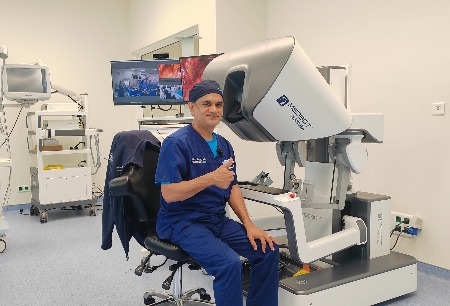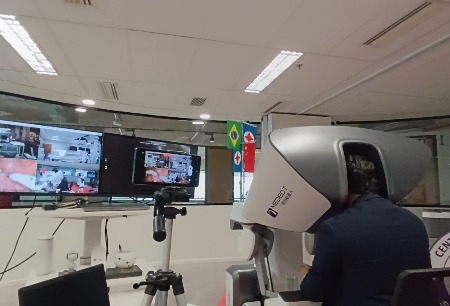Shanghai, China — On October 26th, the Toumai® Laparoscopic Surgical Robot (hereinafter referred to as the Toumai® Robot) assisted the team led by Dr. Chenghong Peng, Director of General Surgery, in a successful operation of pancreaticoduodenectomy at Ruijin Hospital-Shanghai Jiao Tong University School of Medicine (the Ruijin Hospital). This is the first pancreaticoduodenectomy completed by China-made surgical robot. Pancreaticoduodenectomy, known as the Crown Jewel of the surgical procedure, is the most complex, most difficult, and the highest level of abdominal surgery, which is believed to be the “Mount Everest” in the general surgery community. The successful completion of this surgery by Toumai® Robot is a full verification of its safety and reliability in assisting physician for clinical surgery with precise and stable operation. It also signifies the continuous breakthrough of China-made surgical robots represented by Toumai® in clinical application, and their ability to successfully challenge various complex and difficult surgeries.
Patient Profile
The patient was a 53-year-old male who was hospitalized due to discomfort. Pancreatic mass was found by examination. Upper and middle abdomen + lower abdominal or pelvic enhanced CT revealed probable intraductal papillary mucinous neoplasm (IPMN), accompanied by expansion of the main pancreatic duct. Previous cases indicate the possibility of its development into papillary adenoma or papillary adenocarcinoma. After thorough assessment, there was an indication for surgical resection, requiring pancreaticoduodenectomy. The patient strongly requested minimally invasive surgery.
As per Director Chenghong Peng, it is an anatomically deep surgery involving multiple important organs, where surrounding blood vessels are densely distributed, making it a high-risk and difficult surgery. Traditionally, pancreaticoduodenectomy requires the removal of a portion of the stomach, gallbladder, pancreatic head, duodenum, lower common hepatic duct, and common bile duct, followed by pancreaticoduodenal anastomosis, biliary-enteric anastomosis, gastrointestinal anastomosis, and lymph node dissection. The key to surgical success lies in sophisticated anatomical resection and reliable anastomosis, extremely demanding in terms of the smoothness and accuracy of suturing operations.
Although traditional laparoscopic surgery is minimally invasive and accurate enough, it has many restrictions; in contrast, surgical robot is deemed by the industry as the state-of-art minimally invasive surgical platform with clearer and more realistic naked eye 3D surgical field of view. The surgical instrument comes with rotatable wrist, to which the laparoscopy is incomparable, and it features high stability and accuracy with no dead angle, thus greatly improving the flexibility and control range of surgical operations in narrow cavities, making it more conducive for physicians to conducting refined and difficult complex surgeries. Ultimately, with the consent of the patient and his family, it was determined to perform robot-assisted pancreaticoduodenectomy. Director Chenghong Peng and his surgical team prepared a detailed and comprehensive treatment plan.
On October 26th, with the assistance of Deputy Chief Physician Liangchao Zhao, Attending Physician Kai Qin, Dr. Changjie Sun, and the nursing team led by Head Nurse Liying Yang, Director Chenghong Peng manipulated the Toumai® Robot to perform this highly challenging and complex surgery. The whole surgery took only 3.5 hours, where Director Chenghong Peng meticulously completed each surgical step with textbook-like operation. The entire surgery was completed in one go, with only 350ml of bleeding, fully demonstrating the superb surgical skills of the operator and the skilled cooperation of the surgical team. At present, the patient is in good condition and all indicators are stable. The patient is recovering steadily with the care of the medical staff.
Director Chenghong Peng said he was “quite happy” with the success of the surgery. He stated that the robot-assisted pancreaticoduodenectomy came with unique and incomparable benefits. This China-made robot completed the surgery with no discomfort to the patient. The immersive 3D high-definition FOV brought by Toumai® Robot is real, allowing the surgeon to observe the lesion in detail; 7 DOF robotic arm and 540° rotatable wrist surgical instruments are more dexterous than human hands; intuitive master-slave teleoperation control ensures hand-eye coordination for the surgeon, making it sensitive and easy to use and simplifying surgical operations. Under the professional manipulation of a surgeon, Toumai® Robot may better promote wider application of the minimally invasive technology onto complex surgical procedures, achieving accurate operation, delicate resection, and precise suturing to reduce wound size, intraoperative bleeding, and the incidence of complications, which is beneficial for patient recovery.
Director Chenghong Peng has high hopes for Toumai® Robot. He said that surgical robot technology would enjoy wider applications in the medical field in the future and become an indispensable part of medical technology. With the continuous technological changes and challenges, Toumai® Robot requires constant innovation and perfection to make greater contributions to human health.
Mr. Yu Liu, Executive Vice President and Chief Commercial Officer of the MicroPort® MedBot®, noted: Pancreatoduodenectomy has proven to be one of the most difficult surgical procedures in general surgery, which places higher demands on the experience and endurance of the operators, as well as maturity and stability of robots. Director Chenghong Peng is a world-class expert in this field, who is leading an experienced team. This surgery performed by Director Chenghong Peng with the assistance of Toumai® Robot at Ruijin Hospital is the first pancreaticoduodenectomy breakthrough by China-made surgical robot, signifying a memorable achievement in the development history of Toumai® Robot and even the entire sector of domestic surgical robot. For Toumai®, every successful surgery is the verification of the product reliability, stability and safety. We will carefully listen to the advice of experts for continuous optimization, expanding new surgical procedures constantly and assisting physicians in benefiting patients worldwide, so as to eliminate difficult surgery around the world!
-
 2024-11-18Karazanashvili Robotic Center Completed 100 Toumai® Robot-Assisted Surgeries, becoming the Only Robotic Surgery Center in the Caucasus Region
2024-11-18Karazanashvili Robotic Center Completed 100 Toumai® Robot-Assisted Surgeries, becoming the Only Robotic Surgery Center in the Caucasus Region -
 2024-10-26TOUMAI® SURGICAL ROBOT SYSTEM COMPLETES MULTIPLE LANDMARK ROBOTIC TELESURGERY CASES IN SUB-SAHARA AFRICA IN THE REPUBLIC OF ANGOLA
2024-10-26TOUMAI® SURGICAL ROBOT SYSTEM COMPLETES MULTIPLE LANDMARK ROBOTIC TELESURGERY CASES IN SUB-SAHARA AFRICA IN THE REPUBLIC OF ANGOLA -
 2024-10-26Toumai® Achieves South America's First Tele-Surgery Demonstration
2024-10-26Toumai® Achieves South America's First Tele-Surgery Demonstration






 Hu ICP Bei No. 20013662 HGWA Bei No. 31011502015178
Hu ICP Bei No. 20013662 HGWA Bei No. 31011502015178 " are registered trademarks of Shanghai MicroPort Medical (Group) Co., Ltd.” . They have been authorized to be used by Shanghai Microport Medbot (Group) Co., Ltd., and no other party shall use such trademarks without prior written permission thereof.
" are registered trademarks of Shanghai MicroPort Medical (Group) Co., Ltd.” . They have been authorized to be used by Shanghai Microport Medbot (Group) Co., Ltd., and no other party shall use such trademarks without prior written permission thereof.
